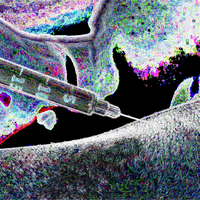| Valium | |||
|---|---|---|---|
| Molecular structure via molpic based on CDK |
| Rotamer [] | |
|---|---|
| Conformer structure via 3Dmol.js |
| Physical properties [] | |
|---|---|
| Molecular mass | 284.74 g/mol [1] |
| Appearance | Colorless to light yellow crysytals [1] |
| Odor | Practically no odor [1] |
| Melting point | 257 to 259 °F (NTP, 1992) [1] |
| Decomposition | When heated to decomp it emits very toxic fumes of hydrogen chloride and NO(x) [1] |
| Solubility | less than 1 mg/mL at 68 °F (NTP, 1992) [1] |
| Predicted LogP | 3 [1] |
| Structural Identifiers [] | |
|---|---|
| Molecular formula | C16H13ClN2O [1] |
| IUPAC name | 7-chloro-1-methyl-5-phenyl-3H-1,4-benzodiazepin-2-one [1] |
| SMILES | CN1C(=O)CN=C(C2=C1C=CC(=C2)Cl)C3=CC=CC=C3 [1] |
| InChI | InChI=1S/C16H13ClN2O/c1-19-14-8-7-12(17)9-13(14)16(18-10-15(19)20)11-5-3-2-4-6-11/h2-9H,10H2,1H3 [1] |
| InChIKey | AAOVKJBEBIDNHE-UHFFFAOYSA-N [1] |
| Pharmacokinetics[] | |
|---|---|
| Elimination half-life | (50 hours); 20–100 hours (32–200 hours for main active metabolite desmethyldiazepam)[5] |
Diazepam
Diazepam (also known as Ansiolisina, Alboral, Methyldiazepinone, Ansiolin, Apozepam, Atensine, Bensedin, Bialzepam, Calmocitene or Calmpose) is a
Chemistry
Salts []
Diazepam is typically found in the form of its hydrochloride salt.
Stereochemistry []
Diazepam is a achiral mixture
| Anodyne Usernotes [] | |||
|---|---|---|---|
| magnus / Diazepam via Oral |
0xea / Diazepam via Oral and Intravenous at 5-30mg oral and 5-10mg intravenous | | |
Experience reports []
There are currently 23 experience reports involving diazepam on OpenErowid:
- "Not Noticing Anything From It"
- "What's the Big Deal"
- "Very Sedative"
- "Slow Motion"
- "Extremely Relaxed"
- "4000mg In Under A Month"
- "The Slippery Slope..."
- "Flyin' on a Magic Carpet"
- "Good High at the Wrong Time"
- "Valuims Strange"
- "Relaxation, Slight Dizziness"
- "Mild but Pleasant"
- "Lose Dose Nausea"
- "Distance Between Reality and Myself"
- "Some Words on After-Effects"
- "Vaginal Insertion"
- "Total Blackout"
- "Like Sailing away...Minus the Costly Yacht"
- "I Really Liked It"
- "Mellow Yellow Fellow"
- "Anxiety Buster, but Not Used to Get 'High'"
- "Everything I Wished Drunkenness Would Be"
- "So Hard to Sleep"
Legal status
- Australia: Diazepam is a S4 substance.[3]
- Brazil: Diazepam is a B1 substance.
- Canada: Diazepam is a Schedule IV substance.
- Germany: Diazepam is a prescription only/Anlage III substance.
- New Zealand: Diazepam is a Class C substance.
- United Kingdom: Diazepam is a Class C substance.[4]
- United States: Diazepam is a Schedule I under the "Controlled Substances Act (CSA)".
- United Nations: Diazepam is a schedule IV substance.
See also []
External links []
References []
National Center for Biotechnology Information. PubChem Compound Summary for CID 3016, Diazepam. Accessed June 25, 2025. https://pubchem.ncbi.nlm.nih.gov/compound/3016
U.S. Food and Drug Administration; National Center for Advancing Translational Sciences. Diazepam. UNII: Q3JTX2Q7TU. Global Substance Registration System. Accessed June 25, 2025. https://gsrs.ncats.nih.gov/ginas/app/beta/substances/Q3JTX2Q7TU
Valium. January 31, 2020. Accessed June 25, 2025. https://www.nps.org.au/medicine-finder/valium-tablets#full-pi
Accessed June 25, 2025. https://www.legislation.gov.uk/ukpga/1971/38/schedule/2/part/III/paragraph/1
Diazepam Tablets BP 10 mgs – Summary of Product Characteristics (SmPC). September 16, 2019. Accessed June 25, 2025. https://www.medicines.org.uk/emc/product/4522/smpc
 Anodyne
Anodyne